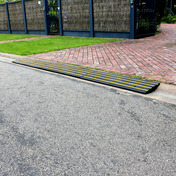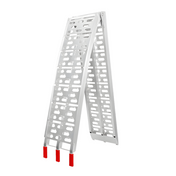Imagine it’s pouring outside and the wheels of your chair hesitate at the entryway ramp.
Or picture blazing sun heating the ramp so much that you’re scared to touch the handrail. Weather changes everyday access—but it doesn’t have to.
In this guide, you’ll learn how to use wheelchair ramps safely at home in all weather, plus how to choose the safest ramp that holds up year‑round.
Why Ramp Safety in All Weather Conditions Matters
A wheelchair ramp is meant to give you safe and easy access in and out of your home. But when the weather changes, so do the risks.
A slip or wobble on a daily ramp can lead to serious injury. By planning for changing conditions and making informed ramp choices, you protect yourself (or your loved one) and increase confidence in independent mobility.
Quick Safety Checklist for Wheelchair Ramps at Home
A few small checks can make a big difference to how safe your ramp feels each day. Use this quick list as a reminder before you head out:
- Make sure the ramp surface is clear of water, leaves, or dirt.
- Check that handrails are secure and easy to grip.
- Look for loose screws, bolts, or worn parts.
- Test that the ramp is steady and not wobbling.
- Keep non-slip mats or grip tape in good condition.
- Watch for sharp edges or cracks in the surface.
- Ensure lighting around the ramp is bright enough at night.
- Keep portable ramps locked in place before use.
How Weather Affects Ramp Safety & What You Can Do

Different types of weather bring different risks. Knowing what to expect can help you prepare and stay safe when using your ramp.
Rain & Moist Conditions
Rain can quickly turn a ramp into a slippery surface. Slow down, use the handrails, and make sure you're using a non-slip wheelchair ramp or have mats in place for better traction. Clearing away puddles and wiping the ramp before use can also make a big difference.
Heat & Sun Exposure
On hot days, metal ramps can heat up and become uncomfortable or even unsafe to touch. Try to check the surface before using the ramp. Shade cloth, covers, or ramps with non-metal surfaces can help keep things cooler.
Cold Weather, Frost, and Ice
Frost and ice can create a serious slip risk. Always check the ramp before use, and if it’s icy, take the time to clear or dry it. Avoid strong chemicals that might damage the ramp. Warm water and safe de-icing products are better options.
Wind, Debris & Storms
Strong winds and storms can blow branches, leaves, and dirt onto ramps. Always clear these away before use. If you use a portable ramp, check that it’s firmly locked into place, as gusts of wind can shift lighter ramps.
How to Use Wheelchair Ramps Safely Step by Step

Using a ramp safely isn’t just about the ramp itself. The way you move on it also matters. Here are some simple steps to follow.
Going Up
- Move at a steady pace rather than rushing.
- Keep your wheelchair straight and centred on the ramp.
- Use the handrails for support if you’re walking or pushing.
- If you’re in a manual wheelchair, ask for help if the slope feels too steep.
Going Down
- Go slowly and keep control of your speed.
- Use the brakes on your wheelchair where possible.
- Stay in the centre of the ramp to avoid slipping off the sides.
- If walking, hold the handrails for balance.
Specifics for Power vs Manual Wheelchairs
- Power wheelchairs: Use the lowest speed setting on slopes. Avoid sudden turns or stops on the ramp.
- Manual wheelchairs: Always check that the helper pushing has a firm grip and steady footing. Small, careful pushes are safer than big, quick ones.
Choosing the Safest Wheelchair Ramp for Your Home
Not all ramps are the same, and choosing the best wheelchair ramp for your home can make daily use much safer and easier. Here are the criteria to prioritise:

Choosing the ramp that meets these standards, like our weather-proof aluminium ramp, will make safety part of the design, not just your habits.
Maintenance and Ongoing Safety Checks
Even the best ramp fails if not maintained. Set aside time monthly or seasonally to:
- Clean the surface: Knowing how to clean wheelchair ramps prevents damage.
- Check for wear and tear: Look for cracks, rust, or parts that may need replacing.
- Tighten bolts and screws: Make sure the ramp is stable and secure.
- Refresh non-slip surfaces: Replace worn grip tape or mats.
- Inspect drainage: Ensure water flows away and doesn’t pool on the ramp.
- Look at handrails: Check that they’re solid, smooth, and comfortable to hold.
FAQs On Wheelchair Ramp Safety

Q: What slope is safe for a home wheelchair ramp?
A: A gentle slope is always safer. Australian Standards recommend 1:14 for permanent ramps.
Q: Can I use salt or de-icer on my wheelchair ramp?
A: Avoid strong chemicals that can damage the surface. Use warm water, a safe de-icing product, or simply clear the ice by hand.
Q: What is the best surface for a non-slip ramp?
A: Textured aluminium, rubber, or ramps with grip tape are all good options for reducing slips.
Q: Are portable ramps safe to use in bad weather?
A: Yes, but they must be locked firmly into place. Always double-check stability before rolling on.
Q: What features make wheelchair ramps for the home safer?
A: Non-slip surfaces, handrails, proper drainage, and the right slope make ramps much safer for everyday use.
Q: Do wheelchair ramps need handrails at home?
A: Handrails aren’t always required, but they add extra support and make the ramp safer in wet or uneven conditions.
Confidence in All Conditions
Weather doesn’t have to make using a wheelchair ramp difficult. With the right habits, regular checks, and a ramp designed for safety, you can feel confident using it every day of the year.
From keeping the surface clear in the rain to checking handrails and choosing a ramp with good non-slip features, small steps can make a big difference.
If you’re looking to make your home safer, Ramp Champ has a wide range of wheelchair ramps for homes built to handle all kinds of conditions.





